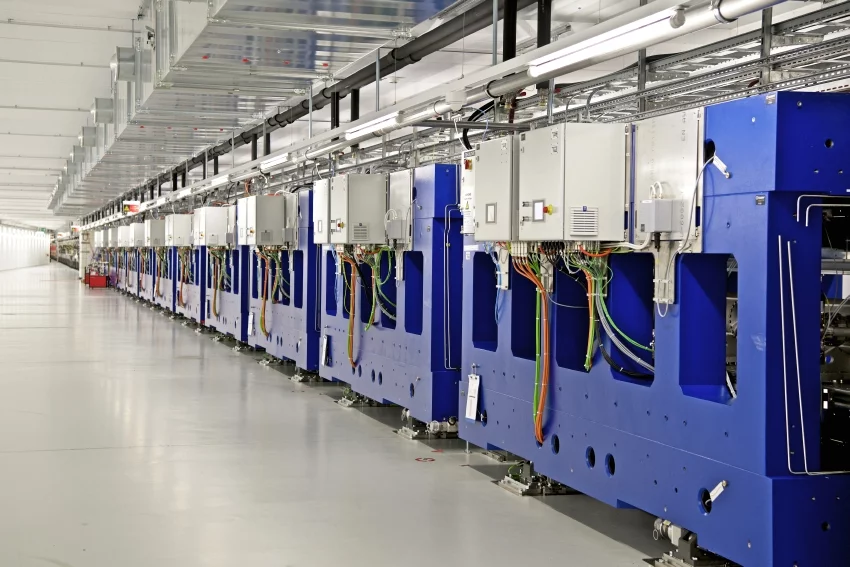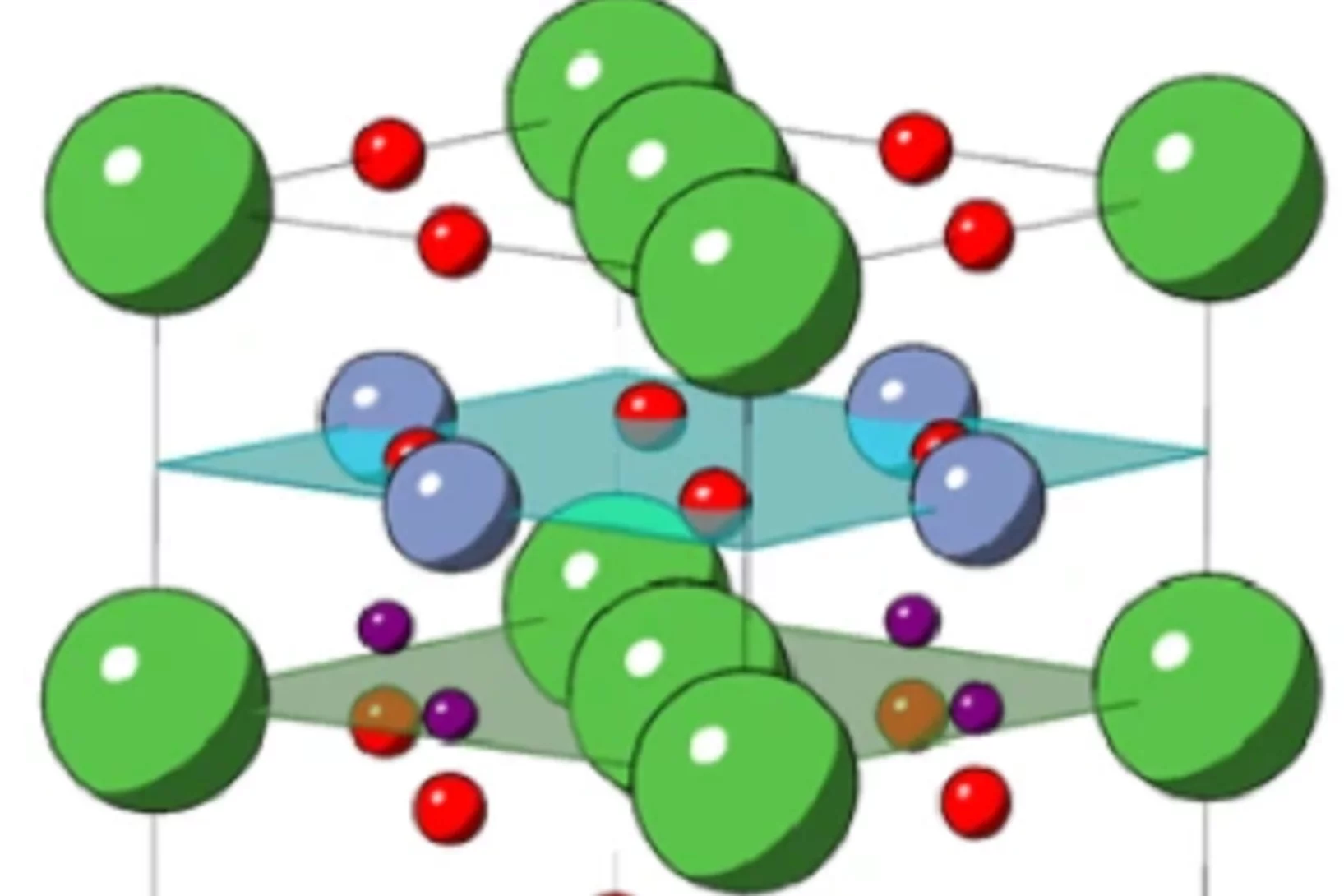
La plus récente grande installation de recherche du PSI génère de très courtes impulsions de rayons X, ayant les propriétés du laser. Cela permet aux chercheurs de suivre des processus extrêmement rapides tels que l'apparition de nouvelles molécules lors de réactions chimiques, de déterminer la structure détaillée de protéines vitales ou de comprendre la composition exacte de matériaux. Les chercheurs pourront ainsi obtenir des informations auxquelles les méthodes actuelles ne permettent pas d'accéder. Les connaissances acquises élargissent notre compréhension de la nature et débouchent sur des applications pratiques telles que de nouveaux médicaments, des processus plus efficaces dans l'industrie chimique ou de nouveaux matériaux en électronique.
Plus d'information sur le sujet SwissFEL
Le dépôt intermédiaire fédéral
Découvrez comment le PSI garantit le stockage intermédiaire des déchets radioactifs provenant de la médecine, de l’industrie et de la recherche (MIF) dans des conditions contrôlées.
Infrastructure
Plongez dans l'approvisionnement énergétique du PSI, admirez les installations impressionnantes dans les domaines de l'électricité, de l'eau, du refroidissement et du chauffage.
Radiopharmacie
Plongez dans le monde fascinant de la radiopharmacie à l'Institut Paul Scherrer. Découvrez comment des substances radioactives sont utilisées pour le diagnostic et le traitement de maladies graves comme le cancer.
Subvention prestigieuse pour la recherche au PSI
Béton, catalyse chimique et quête d’une nouvelle physique: trois chercheurs du PSI ont reçu chacun un grant du Fonds national pour ces thèmes de recherche
A new dimension of complexity for layered magnetic materials
X-rays reveal magnetic phenomena driven by interactions between the layers of a kagome ferromagnet
Pressure-enhanced splitting of density wave transitions in La3Ni2O7–δ
The observation of superconductivity in La3Ni2O7–δ under pressure, following the suppression of a high-temperature density wave state, has attracted considerable attention. The nature of this density wave order was not clearly identified. Here we probe the magnetic response of the zero-pressure phase of La3Ni2O7–δ as hydrostatic pressure is applied, and find that the apparent single density wave transition at zero applied pressure splits into two. The comparison of our muon-spin rotation ...
Outstanding Paper Award
A recent paper by the "Applied Materials Group" of the LNS and their coworkers received the "Outstanding Paper Award" of the journal "Materials and Structures".
Generation IV International Forum (GIF) in Switzerland | hosted by PSI/NES in April 2025
The GIF Technical Secretariat is pleased to inform of the upcoming EG-PG meetings from 7th to 11th April, 2025. This time the host is Switzerland, and the meetings will be organized by PSI's Center for Nuclear Engineering and Sciences.
Spring 2025 | 53rd Expert Group and 59th Policy Group meeting
www.gen-4.org
ReMade@ARI Call Announcement
ReMade@ARI is happy to announce its 5th call for proposals for 2025!
Comment le Botox pénètre dans nos cellules
Des scientifiques du PSI ont identifié des modifications structurelles moléculaires de la neurotoxine bactérienne Botox qui sont importantes pour son absorption par les cellules nerveuses. Cela pourrait permettre à l'avenir des utilisations plus ciblées du Botox en médecine.
Mein Vortrag an der Vertragsunterzeichnung
Ein besonderer Moment – nicht nur für die Lernenden, sondern auch für mich
Spin-orbit control of antiferromagnetic domains without a Zeeman coupling
Encoding information in antiferromagnetic (AFM) domains is a promising solution for the ever growing demand in magnetic storage capacity. The absence of a macroscopic magnetization avoids crosstalk between different domain states, enabling ultrahigh density spintronics while being detrimental to the domain detection and manipulation. Disentangling these merits and disadvantages seemed so far unattainable. We report evidence ...
SwissFEL call for proposals II-25 is open now
The call for SwissFEL proposals II-25 is open.
PSI am diesjährigen KMU Swiss Symposium!
Am 20. März 2025 findet das diesjährige KMU Swiss Symposium in Baden statt – wir freuen uns, dass wir auch in diesem Jahr wieder mit dem Hightech Zentrum einen gemeinsamen Stand haben werden!
De nouvelles voies dans le traitement du cancer
Les études cliniques «RAPID 01» et «PROGNOSTICS» financées par l’ETH/PHRT ont commencé avec succès à recruter des patients.
Anne Flechsig receives the SVMT Prize 2025
On 24th January 2025, Anne Flechsig was awarded the prestigious SVMT Prize for her outstanding master's thesis on "Spatial Patterning of Structural and Transport Properties of Tungsten Thin Films".
Un simulateur quantique unique en son genre ouvre la porte à de nouvelles recherches
Des physiciens du PSI et de Google ont construit un simulateur quantique numérique-analogique innovant.
Evolution of texture and residual stresses in 2205 duplex stainless steel during laser powder bed fusion
This study uses a custom-designed laser powder bed fusion machine, capable of operating in neutron instruments, to track metallic material evolution during additive manufacturing process. More specifically, it investigates the development of residual stresses in textured 2205 duplex stainless steel during laser powder bed fusion. In situ and operando neutron diffraction experiments were conducted to study the transient and real-time evolution of stresses and strains during processing, using an AM machine designed for neutron studies. Additionally, Bragg-edge imaging was employed to investigate the crystallographic texture. The results showed that residual stress redistribution primarily occurs in the first set of added layers when further layers are added on top. The cube texture observed in the sample significantly affects residual stress determination, leading to inaccuracies up to 96 MPa if not accounted for. This highlights the need for orientation-dependent diffraction elastic constants in residual stress calculations. Furthermore, variations in texture intensity across the sample dimensions were found to be driven by changes in the local temperature history, which were deciphered from real-time strain measurements. Finally, this study demonstrates the potential of combining laser powder bed fusion with neutron diffraction to investigate the underlying mechanisms of additive manufacturing in the bulk of the sample.
Anisotropic Skyrmion and Multi-q Spin Dynamics in Centrosymmetric Gd2PdSi3
Skyrmions are particlelike vortices of magnetization with nontrivial topology, which are usually stabilized by Dzyaloshinskii-Moriya interactions (DMI) in noncentrosymmetric bulk materials. Exceptions are centrosymmetric Gd- and Eu-based skyrmion-lattice (SL) hosts with zero DMI, where both the SL stabilization mechanisms and magnetic ground states remain controversial. We address these here by investigating both the static and dynamical spin properties ...
Texture and residual stress evolution during 3D printing
Discover how advanced neutron diffraction sheds light on the evolution of stress and texture in 3D-printed duplex stainless steel.
Vertragsunterzeichnung 2025
Ein feierliches Ereignis für unsere zukünftigen Lernenden und Praktikantinnen
Erfolgreiche Förderung von 4 Projekten im Rahmen des ersten forME Calls
In einer ersten Antragsrunde zum Förderprogramm forME wurden sehr vielfältige und qualitativ hochwertige Projektideen eingereicht. Aufgrund der in der Ausschreibung formulierten Evaluationskriterien wurden vier vielversprechende Anträge ausgewählt, die nun im Rahmen des Förderprogramms Unterstützung für ihr Forschungsprojekt in der Form geschützter Forschungszeit erhalten.
Career at our partner company: Michał Studniarek, Research Team Manager at ABB Corporate Research Center
Before joining ABB Corporate Research Center, I completed my PhD on multifunctional spintronic interfaces at SOLEIL synchrotron and performed research on single molecule magnets at Xtreme beamline of SLS as a PSI-fellow postdoc.
Mapping the ecosystem of Wannier Functions software
A new review article, just published in Reviews of Modern Physics and highlighted on the journal cover, provides a map to the vast landscape of software codes that allow researchers to calculate Wannier functions, and to use them for materials properties predictions. The authors, from all over Europe and the USA, include two PSI scientists. After providing readers with the theoretical foundations on Wannier functions and their calculation, together with intuitive graphical schematics to explain what Wannier functions are, the authors map the existing Wannier codes and the key applications.
Operando phase mapping in multi-material laser powder bed fusion
This study introduces a custom-designed laser powder bed fusion machine, capable of operating in neutron instruments, to track material evolution during additive manufacturing. Using neutron imaging, this study uncovers how complex thermal cycling impacts phase development in multi-material parts, offering new insights into optimizing additive manufacturing processes and enhancing material properties for more precise and high-performance components.
Concurrent Operando Neutron Imaging and Diffraction Analysis Revealing Spatial Lithiation Phase Evolution in an Ultra-Thick Graphite Electrode
Energy-efficient, safe, and reliable Li-ion batteries (LIBs) are required for a wide range of applications. The introduction of ultra-thick graphite anodes, desired for high energy densities, meets limitations in internal electrode transport properties, leading to detrimental consequences. Yet, there is a lack of experimental tools capable of providing a complete view of local processes. Here, a multi-modal operando measurement approach is introduced, enabling quantitative spatio-temporal observations of Li concentrations and intercalation phases in ultra-thick graphite electrodes.
Neutron imaging and diffraction concurrently provide ...
Understanding the Interplay between Artificial SEI and Electrolyte Additives in Enhancing Silicon Electrode Performance for Li-Ion Batteries
Maintaining a stable solid electrolyte interphase (SEI) is crucial for Li-ion battery safety, especially with high-capacity anode containing silicon. Therefore, our study explored long-term cycling of Si electrodes with artificial alucone-based SEI, deposited by molecular layer deposition (MLD) in combination with a fluoroethylene carbonate (FEC) electrolyte additive. MLD of flexible Li-ion permeable artificial SEI coatings onto electrode resulted in improved capacity, enhanced Si electrode cycle life and capacity retention.
Diversity Award 2024
Am 16. Januar 2025 wurde an der Neujahrsinformationsveranstaltung für Mitarbeitende Diversity Award an Marc Janoschek verliehen! Wir gratulieren Marc ebenso wie den beiden anderen Finalist*innen Elisabeth Müller und Giovanni Pizzi für deren Nomination!
Operando Neutron Characterization During 3D Printing
A new laser powder bed fusion device enables real-time neutron diffraction and imaging, providing detailed insights into structural evolution, defect formation, and temperature mapping during metal additive manufacturing.
CSD Christmas
Our Christmas party was a truly unforgettable moment that brought us all a great deal of joy. The festively decorated room was bathed in warm light and the Christmas atmosphere was palpable from the very beginning. The scent of pine branches and mandarins was in the air and contributed to the cozy atmosphere.





























